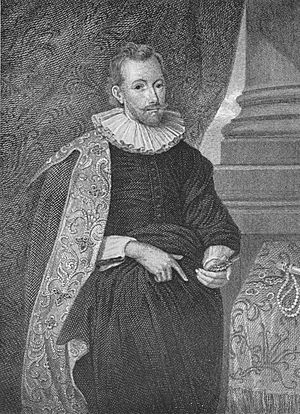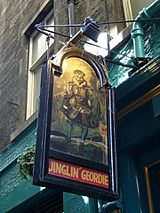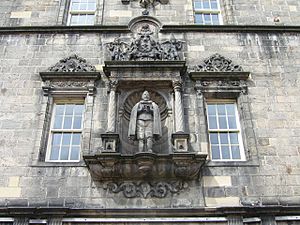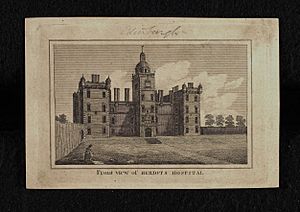George Heriot facts for kids
George Heriot (born June 15, 1563 – died February 12, 1624) was a Scottish goldsmith and a generous person who gave a lot of money to good causes. He is best known today for starting George Heriot's School, a big independent school in Edinburgh, Scotland. His name is also used for Heriot-Watt University and several streets in Edinburgh. People even called him "Jinglin' Geordie" because of the sound of coins in his purse, and there's a pub named after this nickname!
George Heriot was the official goldsmith for Anne of Denmark, who was the wife of King James VI of Scotland. He also worked for the King himself. He became very rich from this job, and even richer by lending money to the King and his court. In 1603, when King James became King of England too (this was called the Union of Crowns), Heriot moved to London with the royal family. He stayed there until he passed away in 1624. He was married twice but didn't have any children who lived past him. So, he decided to leave most of his money to create a hospital to help "faitherless bairns" (which means orphaned children) in his hometown of Edinburgh.
Contents
Early Life and Business
George Heriot was born on June 15, 1563. He was the oldest son of George Heriot, who was also a well-known goldsmith. He was probably born in Corstorphine or Edinburgh. His father was a successful goldsmith from a long-standing family and was even a member of the Scottish Parliament.
On January 14, 1586, George Heriot got engaged to Christian Marjoribanks. Her father was a burgess (a respected citizen) and merchant in Edinburgh. To celebrate his marriage and the end of his training, Heriot's father gave him 1500 merks (an old Scottish coin) to start his own business. He set up a small shop near St. Giles' Cathedral.
He became a burgess of Edinburgh in January 1588 when he was 24. In May of that year, he joined the Edinburgh Goldsmiths' group. By October 1593, he was chosen as the leader, or "Deacon," of the Goldsmiths. Heriot also owned a house in Edinburgh, located on Fishmarket Close near the Royal Mile.
Working for the Royal Family
From the early 1590s, George Heriot began selling items to Anne of Denmark, the Queen. On July 17, 1597, he was officially made the Queen's goldsmith. In those days, a goldsmith didn't just make jewelry; they also acted as bankers. Heriot lent the Queen a lot of money over the years, often using the jewelry he sold her as a guarantee. Queen Anne loved jewelry, and both she and the King often borrowed large sums to pay for their expensive tastes. This made Heriot's business very profitable. It's thought that between 1593 and 1603, he might have done as much as £50,000 worth of business with the Queen!
King James VI also owed Heriot a lot of money for jewelry. In March 1599, the King owed him £6,720 for jewels and precious stones. He even gave Heriot a special jewel with 74 diamonds as a promise to pay him back. Heriot's financial ties with the royal court grew stronger. In 1601, he became the King's official jeweler.
In 1603, King James VI of Scotland also became King James I of England and Ireland. This event was called the Union of the Crowns. King James moved to London, and George Heriot followed him, along with many others from the court. In November, Heriot was appointed a jeweler to the King, with a yearly salary. This salary was small compared to the huge amounts he made from sales and loans. By 1609, Queen Anne owed him £18,000, and Heriot earned a lot of interest from this debt.
Heriot supplied many beautiful pieces of jewelry to Queen Anne. Some of these still exist today! One is a gold case for a miniature portrait, decorated with her initials in diamonds. Another is a pair of earrings with the faces of African men, which might show her interest in how African people were shown in plays, like her own "Masque of Blackness." Heriot also made jewels for Prince Henry, the King's son.
After his first wife, Christian, passed away, Heriot returned to Edinburgh for a short time. He later married Alison Primrose, but she died in 1612, and they had no children. Heriot continued to supply jewels to the court, even to the King's favorite, the Earl of Somerset.
George Heriot was one of the royal jewelers who joined the funeral procession of Queen Anne in 1619. He owned a fancy house in London and a country estate, as well as a lot of property in Edinburgh.
His Legacy
George Heriot died in London in February 1624. He was buried at St. Martin-in-the-Fields church.
Heriot had at least three children with his first wife, Christian: William, Robert, and John. Sadly, two of them may have drowned at sea, but the exact details are not known. He didn't have any other children from his second marriage. However, in his will, he left money for two daughters he had outside of marriage, Elizabeth and Margaret. He also left money to his stepmother, half-siblings, nieces, and nephews.
But the biggest part of his money, about £23,625, was left to the city of Edinburgh. This money was meant to build a hospital for the free education of "puir, faitherless bairns" – poor, orphaned children – whose fathers had been respected citizens of Edinburgh.
Heriot's Hospital began construction in 1628, just outside Edinburgh's city walls, near Edinburgh Castle and Greyfriars Kirk. It was finished just in time to be used by Oliver Cromwell's army during the English Civil War. The hospital officially opened in 1659 with 30 students. Over time, it became very successful and took in other students besides orphans. In the 1880s, it started charging fees, but even today, it continues its original goal by providing free education to many children who have lost a parent.
Memorials
There is a statue of George Heriot inside the courtyard of the school he founded. It's above the entrance tower on the north side. The statue has a Latin message that means: "This statue shows my body, this building shows my soul."
George Heriot is also one of the carved figures on the Scott Monument in Princes Street in Edinburgh. His statue, which is on the lower part of the monument, was carved by Peter Slater. It shows Heriot holding a small model of the school.
In Literature
George Heriot appears as one of two ghosts in a poem called The Ghaists: A Kirk-Yard Ecologue (1773) by Robert Fergusson. He is also a character in the novel The Fortunes of Nigel by Sir Walter Scott.
| Article contributor: Ray Harriot. Ray is a Historian of the Herriott Heritage Association and the author of “Beyond Trabroun: The Heriots of Scotland (1400-1700)” and “A Historical Perspective: The Heriot and Herriott Families of South Carolina”. |
See also
- William Fettes, another Edinburgh businessman, after whom Fettes College is named.
- List of universities named after people






